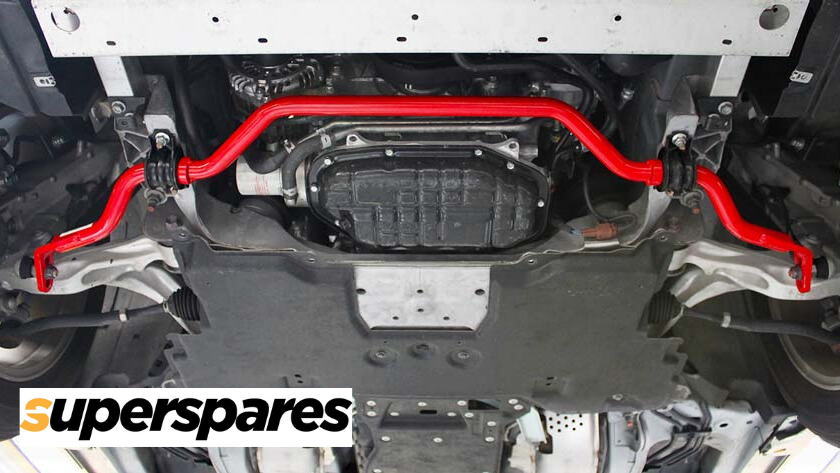Sway Bar Buying Guides
Author: superspares

Sway Bar Basics
A sway bar is a long metal crossbar that ties the driver and passenger side chassis and suspension together. When a car is travelling straight down the road or track, a sway bar has little effect on handling. But as soon as you turn the steering wheel and enter a corner, a sway bar "springs" to life.
As your vehicle turns, it also begins to roll sideways. This rolling effect is created when the inertial weight of the vehicle wants to continue traveling straight down the road even as you crank on the steering wheel. The sway bar transfers the force of vehicle roll across to the outside corner of the suspension via a twisting motion. Then, as it untwists, the bar returns the force back again to the inside corner. This give and take opposition counter-balances itself across the sway bar, with the happy side effect of reducing or eliminating body roll.
Many vehicle manufacturers incorporate some form of anti-roll technology into their vehicle suspension designs. However, the vast majority of drivers are more interested in comfort and neutral handling than a taut, responsive ride that's more sporty than sedate.
Enjoying above-average handling requires modifying the factory suspension settings. Adding sway bars is a big step in the right direction. For some drivers, a set of quality swaybars is all they need to get the sharper handling and responsiveness they desire.
What Does a Sway Bar Do Exactly?
A sway bar basically distributes weight across all 4 wheels as evenly as possible, i.e. if 1 wheel experiences a load or a weight, this weight is transferred to the other wheel as well. This prevents the car from rolling over as well as excessive weight shifting between wheels cannot take place, all this accounts as well for a rewarding driving experience as it does for a forgettable one; depending on how the sway bar is adjusted. Also, as result of this behavior, the sway bar also controls the responsiveness of a vehicle, namely the driving under-steer or over-steer, and how well a vehicle turns corners at high speed. It is therefore, very essential that any adjustments to the sway bar are done with care, the following simple tips shall give a fair idea of how to maintain a standard suspension and the effects that minor adjustments to the sway bar may have on the driving experience.
Which Sway Bar is Right for You?
The best sway bar for you depends on how you'll use your vehicle. Is it a daily driver, canyon carver, weekend track car, full time race car, rock crawler or high speed desert mauler?
This is the most important consideration, because it's all too easy to pick the wrong sway bar for your ride. For example, if your car is used mainly for daily driving and you install an aggressive sway bar rated at 200% stiffer than stock, your cornering performance, ride quality and traction will suffer on real world road surfaces.
Let's say your driver side front wheel hits a bump mid-turn. Stock suspension or a moderately stiff aftermarket sway bar will transfer some of the energy to the passenger side front wheel. No biggie.
But an extremely stiff sway bar will transfer much more of the energy - maybe enough to unsettle the suspension and reduce traction by creating tire lift on the inside wheel and excessive sidewall flex on the outside tire.
What are the Alternatives to Adjusting a Sway Bar?
There are several quick fix solutions that impact the driving experience in the same manner as a sway bar adjustment does, you should always consider these before actually adjusting the sway bar. A very simple, albeit temporary, solution is to let some air out of one set of tires, either the front or the rear. If you car does not have adjustable sway bars, you can just change the bushings with aftermarket offerings on the side of the vehicle where you want a stiffer suspension. Additionally, if your car has adjustable shocks, you can change their stiffness too for the same impact on driving experience.
Sway Bar Adjustment
Here is a look at how different adjustments affect the suspension as a whole.
Soft Front Bar
- Increases front traction of the car while decreasing the rear traction.
- Increases the roll of the car.
- Under steers the vehicle.
Stiff Front Bar
- Decreases front traction of the car while increasing the rear traction.
- Decreases the roll of the car.
- Over steers the vehicle.
Soft Rear Bar
- Increases car roll.
- Decreases front traction while increasing rear traction.
Stiff Rear Bar
- Decreases car roll.
- Increases front traction while decreasing rear traction.
- Increases Steering sensitivity during high speed cornering.
As even minor changes can have sizable impacts, it is suggested that any adjustments to sway bar suspension are done with great care and if possible, using professional tools.
Other Tips
Adjust the suspension while a person of approximately your own weight sits in the driving seat. Also make sure that the car’s sway bar remains parallel to the ground for optimal performance.







